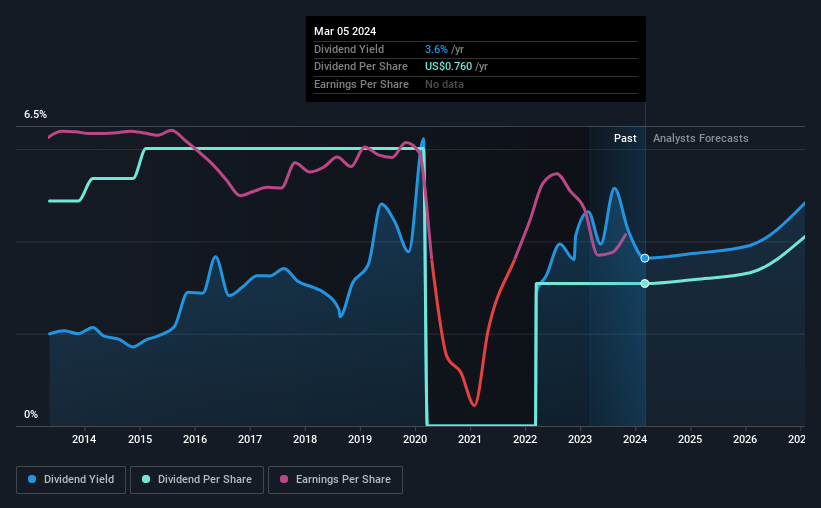Don't Buy Nordstrom, Inc. (NYSE:JWN) For Its Next Dividend Without Doing These Checks
Readers hoping to buy Nordstrom, Inc. (NYSE:JWN) for its dividend will need to make their move shortly, as the stock is about to trade ex-dividend. The ex-dividend date is usually set to be one business day before the record date which is the cut-off date on which you must be present on the company's books as a shareholder in order to receive the dividend. The ex-dividend date is important as the process of settlement involves two full business days. So if you miss that date, you would not show up on the company's books on the record date. Accordingly, Nordstrom investors that purchase the stock on or after the 11th of March will not receive the dividend, which will be paid on the 27th of March.
The company's next dividend payment will be US$0.19 per share. Last year, in total, the company distributed US$0.76 to shareholders. Based on the last year's worth of payments, Nordstrom stock has a trailing yield of around 3.6% on the current share price of US$20.90. We love seeing companies pay a dividend, but it's also important to be sure that laying the golden eggs isn't going to kill our golden goose! So we need to check whether the dividend payments are covered, and if earnings are growing.
See our latest analysis for Nordstrom
If a company pays out more in dividends than it earned, then the dividend might become unsustainable - hardly an ideal situation. Last year, Nordstrom paid out 103% of its income as dividends, which is above a level that we're comfortable with, especially if the company needs to reinvest in its business. A useful secondary check can be to evaluate whether Nordstrom generated enough free cash flow to afford its dividend. Thankfully its dividend payments took up just 42% of the free cash flow it generated, which is a comfortable payout ratio.
It's disappointing to see that the dividend was not covered by profits, but cash is more important from a dividend sustainability perspective, and Nordstrom fortunately did generate enough cash to fund its dividend. Still, if the company repeatedly paid a dividend greater than its profits, we'd be concerned. Very few companies are able to sustainably pay dividends larger than their reported earnings.
Click here to see the company's payout ratio, plus analyst estimates of its future dividends.
Have Earnings And Dividends Been Growing?
Companies with falling earnings are riskier for dividend shareholders. Investors love dividends, so if earnings fall and the dividend is reduced, expect a stock to be sold off heavily at the same time. Nordstrom's earnings per share have fallen at approximately 22% a year over the previous five years. When earnings per share fall, the maximum amount of dividends that can be paid also falls.
The main way most investors will assess a company's dividend prospects is by checking the historical rate of dividend growth. Nordstrom's dividend payments per share have declined at 4.5% per year on average over the past 10 years, which is uninspiring. It's never nice to see earnings and dividends falling, but at least management has cut the dividend rather than potentially risk the company's health in an attempt to maintain it.
Final Takeaway
From a dividend perspective, should investors buy or avoid Nordstrom? It's never great to see earnings per share declining, especially when a company is paying out 103% of its profit as dividends, which we feel is uncomfortably high. However, the cash payout ratio was much lower - good news from a dividend perspective - which makes us wonder why there is such a mis-match between income and cashflow. With the way things are shaping up from a dividend perspective, we'd be inclined to steer clear of Nordstrom.
So if you're still interested in Nordstrom despite it's poor dividend qualities, you should be well informed on some of the risks facing this stock. Our analysis shows 4 warning signs for Nordstrom and you should be aware of these before buying any shares.
Generally, we wouldn't recommend just buying the first dividend stock you see. Here's a curated list of interesting stocks that are strong dividend payers.
Have feedback on this article? Concerned about the content? Get in touch with us directly. Alternatively, email editorial-team (at) simplywallst.com.
This article by Simply Wall St is general in nature. We provide commentary based on historical data and analyst forecasts only using an unbiased methodology and our articles are not intended to be financial advice. It does not constitute a recommendation to buy or sell any stock, and does not take account of your objectives, or your financial situation. We aim to bring you long-term focused analysis driven by fundamental data. Note that our analysis may not factor in the latest price-sensitive company announcements or qualitative material. Simply Wall St has no position in any stocks mentioned.

